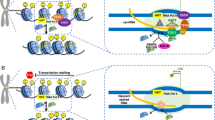Abstract
Human chromosomes were in situ nick-translated using as nicking agents the endonucleases MspI (CCGG), its methyl-sensitive isoschizomer HpaII, HaeIII (GGCC), SacII (CCGCGG), EcoRI (GAATTC) and DNaseI. We show that in metaphase chromosomes R-bands are enriched, as compared with G-bands, in the dinucleotide CpG but no more than what is expected on the basis of their relative G+C content. The telomeric regions, on the contrary, besides having a chromatin conformation that is particularly relaxed and accessible to endonucleases, also show an enrichment in CpGs.
Similar content being viewed by others
References
Adolph S, Hameister H (1990) In situ nick translation of human metaphase chromosomes with restriction enzymes MspI and HpaII reveals an R-band pattern. Cytogenet Cell Genet 54:132–136
Ambros PF, Sumner AT (1987) Correlation of pachytene chromomeres and metaphase bands of human chromosomes, and distinctive properties of telomeric regions. Cytogenet Cell Genet 44:223–228
Antequera F, Mcleod D, Bird A (1989) Specific protection of methylated CpGs in mammalian nuclei. Cell 58:509–517
Bickmore WA, Bird AP (1992) Use of restriction endonucleases to detect and isolate genes from mammalian cells. Methods Enzymol 316:224–244
Bickmore WA, Summer AT (1989) Mammalian chromosome banding — an expression of genome organization. Trends Genet 5:144–148
Bird AP (1987) CpG islands as gene markers in the vertebrate nucleus. Trends Genet 3:342–347
Brown WRA, Bird AP (1986) Long-range restriction site mapping of mammalian genomic DNA. Nature 322:477–481
Bullerdiek J, Dittmer J, Faehre A, Bartnitzke S, Kasche V, Scloot W (1985) A new banding pattern of human chromosomes by situ nick translation using EcoRI and biotin-dUTP. Clin Genet 28:173–176
Burgos M, Jimenez R, Sanchez A, Diaz de la Guardia R (1992) Restriction enzyme banding and in situ nick translation on different types of hetero- and euchromatin. Exp Cell Res 202:545–548
Burkholder GD (1989) Morphological and biochemical effects on isolated mammalian chromosomes in vitro. Chromosoma 97:347–355
de la Torre J, Mitchell AR, Sumner AT (1991) Restriction endonuclease/nick translation of fixed mouse chromosomes: A study of factors affecting digestion of chromosomal DNA in situ. Chromosoma 100:203–211
Ferraro M, Prantera G (1988) Human NORs show correlation between transcriptional activity, DNase I sensitivity, and hypomethylation. Cytogenet Cell Genet 47:58–61
Gardiner-Garden M, Frommer M (1987) CpG islands in vertebrate genomes. J Mol Biol 196:261–282
Holmquist GP (1988) DNA sequences in G-bands and R-bands. In: Adolph KW (ed) Chromosomes and chromatin. CRC Press, Boca Raton, Florida, pp 75–120
Holmquist GP (1989) Evolution of chromosome bands: molecular ecology of noncoding DNA. J Mol Evol 28:469–486
ISCN (1985) An international system for human cytogenetic nomenclature, Harnden DG, Klinger HP (eds). Karger, Bael New York
Kerem BS, Goitein R, Diamond G, Cedar H, Marcus M (1984) Mapping of DNase I sensitive regions on mitotic chromosomes. Cell 38:493–499
Mezzanotte R, Bianchi U, Vanni R, Ferrucci L (1983) Chromatin organization and restriction endonuclease activity on human metaphase chromosome. Cytogenet Cell Genet 36:562–566
Miller DA, Choi Y-C, Miller OJ (1983) Chromosome localization of highly repetitive human DNA's and amplified ribosomal DNA with restriction enzymes. Science 219:395–397
Obe G, Vasudev V, Johannes C (1987) Chromosome aberrations induced by restriction endonucleases. In: Obe G, Basler A (eds) Cytogenetics, basic and applied aspects. Springer, Berlin Heidelberg New York, pp 300–314
Perry P, Wolff S (1974) New method for differential staining of sister chromatids. Nature 251:156–158
Prantera G, Ferraro M (1990) Analysis of methylation and distribution of CpG sequences on human active and inactive X chromosomes by in situ nick translation. Chromosoma 99: 18–23
Saccone S, De Sario A, Della Valle G, Bernardi G (1992) The highest gene concentrations in the human genome are in telomeric bands of metaphase chromosomes. Proc Natl Acad Sci USA 89:4913–4917
Sahasrabuddhe GD, Pathak S, Hsu TC (1978) Responses of mammalian metaphase chromosomes to endonuclease digestion. Chromosoma 69:331–338
Sentís C, Ludeña P, Fernandez-Piqueras J (1993) Non-uniform distribution of methylatable CCGG sequences on human chromosomes as shown by in situ methylation. Chromosoma 102:267–271
Stoilov L, Mullenders LHF, Natarajan AT (1986) Influence of bromodeoxyuridine substitution of thymidine on sister chromatid exchanges and chromosomal aberrations induced by restriction endonucleases. Mutat Res 174:295–301
Viegas-Pequignot E, Dutrillaux B, Thomas G (1988) Inactive X chromosome has the highest concentration of unmethylated HhaI sites. Proc Natl Acad Sci USA 85:7657–7660
Waalwijk C, Flavell RA (1978) DNA methylation at a CCGG sequence in the large intron of the rabbit β-globin gene: tissue-specific variations. Nucleic Acids Res 5:4631–4640
Wright JH, Gottschling DE, Zakian VA (1992)Saccharomyces telomeres assume a non-nucleosomal chromatin structure. Genes Dev 6:197–210
Author information
Authors and Affiliations
Additional information
Communicated by: A. Bird
Rights and permissions
About this article
Cite this article
Ferraro, M., Predazzi, V. & Prantera, G. In human chromosomes telomeric regions are enriched in CpGs relative to R-bands. Chromosoma 102, 712–717 (1993). https://doi.org/10.1007/BF00650897
Received:
Revised:
Accepted:
Issue Date:
DOI: https://doi.org/10.1007/BF00650897




